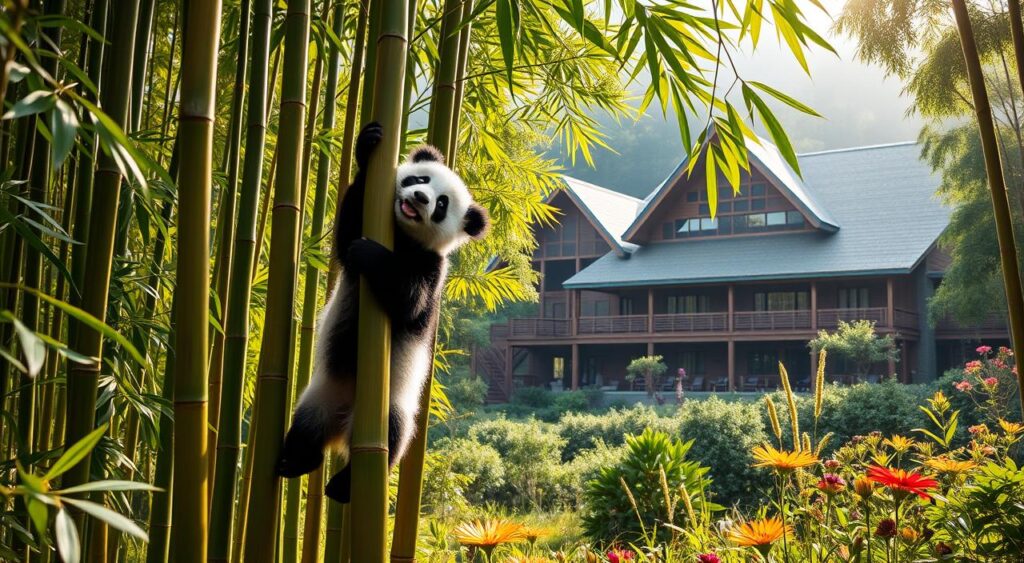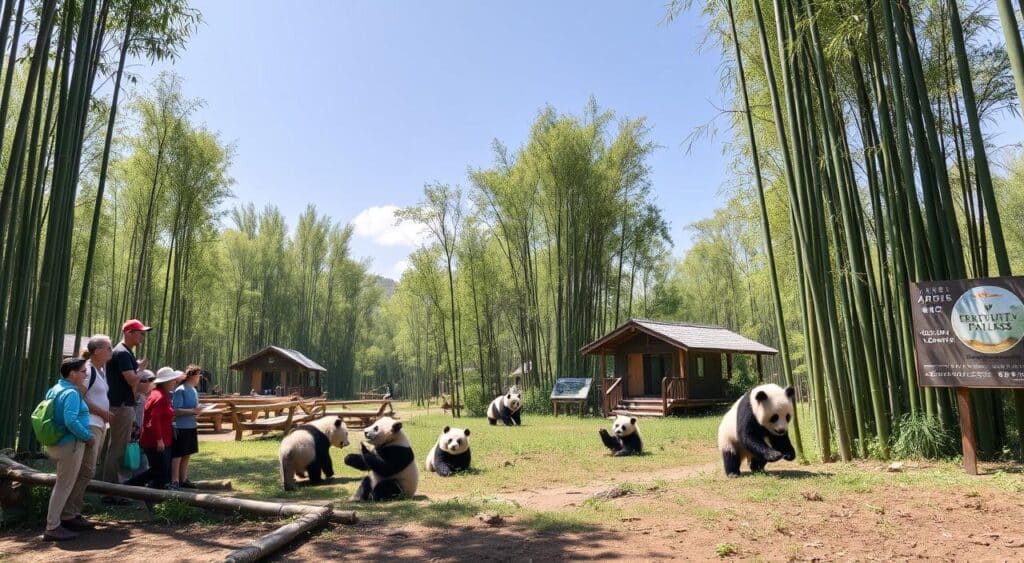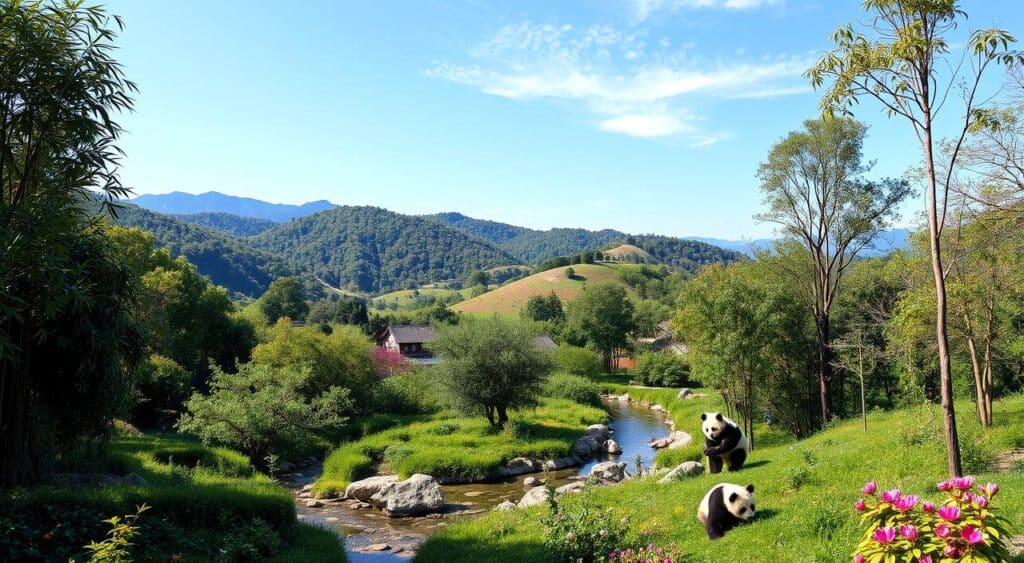Eco-tourism has become a key player in saving the giant pandas. It gives local communities jobs and helps them protect panda homes. Even when the pandemic stopped trips, eco-tourism is back and helping a lot.
This approach helps local economies grow. It also encourages people to keep red pandas and giant pandas safe. It’s a big win for both nature and people.
Key Takeaways
- Eco-tourism has been a key driver of panda conservation success stories.
- Local communities are empowered to protect panda habitats through sustainable livelihoods from eco-tourism.
- The pandemic temporarily halted eco-trips, but they are now back as a crucial conservation strategy.
- Eco-tourism benefits local economies and incentivizes communities to safeguard red panda and giant panda habitats.
- Collaborative efforts between local communities, conservation organizations, and the government are essential for panda conservation through eco-tourism.
The Role of Eco-Tourism in Panda Conservation
Providing Sustainable Livelihoods for Local Communities
Eco-tourism is key in helping protect pandas. It gives local communities jobs that don’t harm the environment. In Nepal, for example, the Red Panda Network helps people switch to jobs like running homestays.
This not only increases their income but also encourages them to protect red pandas and their homes.
In China’s Guanba village, eco-tourism has opened up new job paths. Young people now work as park rangers and guides instead of harming panda habitats. The Wanglang Nature Reserve, covering 320 km2, is home to 32 wild giant pandas and many other rare species.
Tourism in Wanglang grew from 1,000 visitors in 1997 to 20,000 in 2002. This boost helped the local economy.
Over 30 tour guides and managers took part in an ecotourism workshop in Mianyang city. Also, 35 people from the Baima community joined an ecotourism training workshop by WWF. These workshops aimed to make tourism more eco-friendly and sustainable.
Eco-tourism is crucial for panda conservation. It offers jobs that help protect pandas and their habitats. By supporting local communities, eco-tourism plays a big role in saving the giant panda.
Empowering Local Communities Through Eco-Tourism

Eco-tourism gives local communities a chance to make a living in a green way. It also lets them lead in protecting pandas. In Guanba, China, people used to hunt and log. Now, they help protect the environment as park rangers.
Groups like the Shan Shui Conservation Center help local people take charge of conservation. They respect their culture and traditions. This way, eco-tourism makes communities strong in protecting pandas and the environment.
In India, the Singchung Bugun Village Community Reserve is a great example. It’s 17 square kilometers big and has 1,500 people. The Bugun tribe gave land to protect endangered birds and red pandas.
| Eco-Tourism Initiative | Key Metrics |
|---|---|
| Singchung Bugun Village Community Reserve |
|
Through eco-tourism, places like Guanba and the Bugun tribe show its power. They prove it’s a strong way to protect pandas and other endangered animals in China and India.
“Eco-tourism has empowered us to become the main force in protecting the environment. We take great pride in our role as park rangers and conservation supporters.”
– A resident of Guanba, China
Panda Conservation Success Stories

Panda conservation has seen big wins in recent years, thanks to eco-tourism. In Guanba, China, a valley once clear-cut is now home to five giant pandas and other endangered species. This change came from community efforts and support from groups like the WWF and Conservation International.
In Nepal, eco-tourism has protected red panda homes and helped their numbers grow. Local guides and homestay owners are key to these successes. The Panchthar-Ilam-Taplejung (PIT) corridor is home to 25% of Nepal’s red pandas, and the PIT Red Panda Protected Forest is the first for red pandas worldwide.
- The Forest Guardian (FG) program in Nepal has over 100 members, including Bimala Moktan, who joined at 24 and is now 27, and Ngima Sherpa, a member since 2014.
- Menuka Bhattarai has been with the FG team for about eight years, working to protect red pandas.
- Nepal’s first red panda GPS-satellite study tracked ten pandas to learn about their habits and habitats.
Eco-tourism is a game-changer for giant pandas and red pandas. It empowers local communities and offers sustainable jobs. This makes eco-tourism a key part of panda conservation worldwide.
“Our conservation work has not only protected the pandas, but also revived the local economy and improved the livelihoods of the community. This is a true win-win situation.”
– Dr. Zhao Xiang, Conservation Biologist at the China Conservation Biology Institute
Economic Benefits and Uneven Distribution

Eco-tourism has brought big economic gains to areas near panda homes in China. But, there’s a big problem: the benefits aren’t shared fairly. A study on the Wolong Nature Reserve, where giant pandas live, shows us why.
Most of the money from eco-tourism goes to people outside local communities. These communities, which protect panda homes, don’t get much. They have to change their way of life to help, but they don’t see the money.
Addressing the Unequal Distribution of Benefits
This unfair sharing of benefits can make people less willing to help protect pandas. To fix this, experts suggest a few things:
- Get local people more involved in eco-tourism and making decisions.
- Use more local products and services to keep more money in the community.
- Move some rural homes closer to eco-tourism spots to share the benefits better.
| Statistic | Value |
|---|---|
| Approximately 80% of China’s nature reserves have developed eco-tourism programs | 80% |
| Nearly 16% of nature reserves in China host more than 100,000 visitors annually | 16% |
| The total number of visitors to 11 nature reserves in China almost doubled from 942,000 to 1,770,000 between 1995 and 1998 | 1,770,000 |
| Wolong Nature Reserve, home to giant pandas in China, has an area of 2000 km² | 2000 km² |
| In 2000, Wolong Nature Reserve had more than 4400 local rural residents, mainly farmers | 4400 |
By making sure everyone gets a fair share of eco-tourism benefits, we can help protect pandas better. This way, we can keep their homes safe for a long time.
The Giant Panda National Park Initiative

China has made big steps in saving pandas with the Giant Panda National Park. It covers over 22,000 square kilometers. This project, backed by the Global Environment Facility, aims to better protect panda homes and more.
The park knows how important local people are. They live around and between nature reserves. Their help is crucial for saving pandas.
The Giant Panda National Park wants to keep pandas and their homes safe. It’s a big deal for China to protect charismatic giant pandas and their homes. This includes the famous xiao qi ji that people love for over 80 years of panda conservation.
The park is all about working together with local communities. This is a big step for saving the giant panda and its friends. It helps China’s own conservation work and opens doors for working with others outside of China.
As we see the first panda from panda diplomacy, the Giant Panda National Park shows China’s big commitment to wildlife. It shows China’s leadership in saving animals and nature.
The China Wildlife Conservation Association and top research groups are key to the park. They work hard to breed pandas and create new ways to save them. The Giant Panda National Park is a big step for China in saving its national symbol and the places they live.
International Collaboration and Support

The conservation of China’s giant pandas has greatly benefited from international help. The World Wildlife Fund (WWF) has been a key partner in protecting these animals and their homes.
Groups like Conservation International and the Shan Shui Conservation Center have also been crucial. They support local conservation efforts. The Global Environment Facility has given important funding and help for projects in China, including the Giant Panda National Park.
This global teamwork has been key to panda conservation success in China. For example, the National Zoo in the United States has hosted giant pandas for 50 years. Mei Xiang and Tian Tian are the latest pair to live there.
| Collaboration Highlights | Achievements |
|---|---|
| National Zoo and Conservation Biology Institute |
|
| Global Environment Facility |
|
This international teamwork and support are vital for saving china’s giant panda population. Together, we can keep giant pandas safe and protect nature for future generations.
Challenges and Opportunities for Sustainable Eco-Tourism

Eco-tourism is a key tool in panda conservation. Yet, it faces challenges for long-term success. Habitat loss and fragmentation are major concerns. So is keeping wild panda populations healthy.
Conservation groups and governments must work together. They need to create strong panda nature reserve networks. They also must improve habitat conservation and support breeding programs.
It’s also important to share eco-tourism benefits fairly. This includes local communities. Their support is crucial for conservation initiatives.
By tackling these challenges, eco-tourism can help more with panda conservation. It can offer local communities alternative livelihoods. This empowers them to protect their natural resources and funds conservation projects.
The international union for the conservation of nature (IUCN) is working hard. They are breeding pandas and protecting their homes. This makes the future of the wild giant panda look hopeful.
By focusing on panda conservation and using eco-tourism, we can save this iconic species. This is a hopeful future for the wild giant panda.
| Challenges | Opportunities |
|---|---|
|
|
Eco-tourism can be a key player in panda conservation. By facing challenges and seeing opportunities, it can help save this iconic species.
Also Read: Giant Panda Conservation: Success Stories and Challenges
Conclusion
Eco-tourism is a key player in saving giant pandas and other endangered animals. It helps local communities earn a living and protects panda homes. This has led to big wins in China, Nepal, and other places.
China’s “panda diplomacy” has brought pandas to the world. This has helped make global conservation better and has shared knowledge across borders.
But, there are still hurdles to overcome. Making sure everyone gets a fair share of the benefits and keeping these programs going for a long time is tough. Scientists and researchers keep learning about pandas to improve how we protect them.
Places like the Chengdu Research Base and the China Conservation and Research Center are breeding pandas. They have made many panda cubs, helping the species grow.
The future for pandas looks good. The number of pandas is going up, and the IUCN changed their status to “vulnerable” in 2016. With more teamwork, research, and community involvement, pandas will be safe for a long time.
The giant panda is a symbol of hope for our planet. It shows us how important it is to protect our world and its creatures.
FAQs
Q: How does eco-tourism help in the conservation of wild pandas?
A: Eco-tourism supports panda conservation by generating funds that are used for the protection of panda habitats and the establishment of panda reserves, ultimately leading to successful conservation efforts.
Q: Why are giant pandas considered endangered?
A: Giant pandas are considered endangered primarily due to habitat loss and the destruction of bamboo forests, which are essential for their survival. Conservation programs aim to restore and protect these habitats.
Q: What role does the Chinese government play in panda conservation?
A: The Chinese government plays a crucial role in panda conservation by implementing policies that protect panda habitats, funding conservation programs, and establishing panda reserves to increase wild panda numbers.
Q: Can eco-tourism lead to the successful breeding of baby pandas?
A: Yes, eco-tourism can lead to successful breeding of baby pandas by providing financial resources for breeding programs and promoting awareness about the importance of protecting the giant panda species.
Q: What has been the impact of panda diplomacy on conservation success?
A: Panda diplomacy has paved the way for international cooperation in panda conservation, facilitating research and funding that have led to conservation success and increased awareness of the plight of giant pandas.
Q: What happens to pandas in the wild if conservation efforts are not successful?
A: If conservation efforts are not successful, wild panda populations could continue to decline, potentially leading to extinction and the loss of these iconic animals from their natural habitats.
Q: How does the return of pandas to China from zoos in the U.S. contribute to conservation?
A: The return of pandas, such as Qi Ji from the Memphis Zoo, to China supports conservation by contributing to breeding programs and helping to maintain genetic diversity among the current panda population.
Q: What is the significance of panda reserves in increasing wild panda numbers?
A: Panda reserves are significant because they provide a protected environment where pandas can thrive, ensuring that their natural habitats are preserved and that they have access to bamboo, which is vital for their survival.
Q: Are there any successful stories of panda conservation that have emerged from eco-tourism initiatives?
A: Yes, successful stories have emerged from eco-tourism initiatives, such as increased funding for conservation projects and the establishment of new panda reserves, which have contributed to the recovery of wild panda populations.

